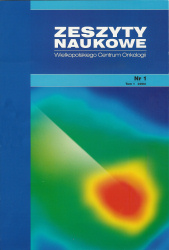Abstrakt
Nowotwór piersi jest to nowotwór złośliwy powstający z komórek gruczołu piersiowego, który rozwija się miejscowo w piersi oraz daje przerzuty do węzłów chłonnych i narządów wewnętrznych (płuc, wątroby, kości i mózgu). Ponad 23% zachorowań na nowotwory kobiet w Polsce, jak i na świecie stanowią nowotwory piersi. Na przestrzeni ostatnich lat techniki napromieniania nowotworów piersi ulegają ciągłemu rozwojowi. Celem pracy było poglądowe przedstawienie technik radioterapeutycznych stosowanych w napromienianiu nowotworów piersi, od dwuwymiarowej 2D techniki statycznej poprzez techniki dynamiczne (IMRT technika z modulacją intensywnością dawki (ang. intensity modulated radiation therapy), VMAT technika obrotowa z modulacją intensywności dawki (ang. volumetric modulated arc therapy), aż do techniki DIBH techniki napromieniania na głębokim wstrzymanym wdechu (ang. deep inspiration breath hold). W pracy skupiono się na przedstawieniu realizacji omawianych technik i opisie jak dana technika wpływa na rozkład dawki w planowanej objętości do napromieniania PTV (ang. Planning Target Volume) oraz na dawki w narządach krytycznych w radioterapii nowotworów piersi.
Bibliografia
Kordek R. Onkologia. Podręcznik dla studentów i lekarzy. Kordek R. (red). Wydawnictwo Medyczne ViaMedica, Gdańsk 2007.
Meder J. Radioterapia nowotworów. Onkologia kliniczna. Krzakowski M. (red). Wydawnictwo Borgis, Warszawa 2006.
Krajowy rejestr nowotworów. http://onkologia.org.pl
Darby S, McGale P, Correa C, et al. Review Effect of radiotherapy after breast-conserving surgery on 10-year recurrence and 15-year breast cancer death: meta-analysis of individual patient data for 10,801 women in 17 randomised trials. Early Breast Cancer Trialists' Collaborative Group (EBCTCG). Lancet. 2011; 378:1707-16,
Bentzen S.M, Constine L.S, Deasy J.O, et al. Quantitative Analyses of Normal Tissue Effects in the Clinic (QUANTEC): An Introduction to the Scientific Issues. Int J Radiat Oncol Biol Phys. 2010;76:3–9.
Ahmad S, Duke S, Jena R, et al. Advances in radiotherapy. BMJ. 2012; 345:65-77.
Siiskonen T, Kaijaluoto S, Florea T, et al. Imaging practices and radiation doses from imaging in radiotherapy. Physica Medica. 2017;42:247-252.
Arthur D , Arnfield M, Warwicke L, et al. Internal mammary node coverage: an investigation of presently accepted techniques. Int J Radiat Oncol Biol Phys 2000;48(1):139-46.
Das I.J. Lung and heart dose volume analyses with CT simulator in radiation treatment of breast cancer. Int J Radiat Oncol Biol Phys 1998;42:11-9.
Pierce L J, Butler J, Martel M K, et al. Postmastectomy radiotherapy of the chest wall: dosimetric comparison of common techniques. Int J Radiat Oncol Biol Phys. 2002;52:1220-30.
Cho B. Intensity-modulated radiation therapy: a review with a physics perspective. Radiat Oncol J. 2018; 36:1–10.
Ziólkowska E, Wisniewski T, Kubiak M, et al. IMRT technique in patients with breast cancer treated with breast conserving therapy - obstacles and advantages. Współczesna Onkologia. 2007;11:475-80.
Yeh H P, Huang Y, Wang L Y, et al. Helical tomotherapy with a complete-directional complete block technique effectively reduces cardiac and lung dose for left-sided breast cancer. Br J Radiol. 2020;93:20190792.
Ma C, Zhang W, Lu J, et al. SU-E-P-56: Dosimetric Comparison of Three Post Modified Radical Mastectomy Radiotherapy Techniques for Locally Advanced Left-Sided Breast Cancer and Beyond. Biomed Res Int. 2020; 2020:7131590.
Sankar A, Velmurugan J. Different intensity extension methods and their impact on entrance dose in breast radiotherapy: A study. J Med Phys. 2009;34:200–05.
Farace P , Zucca S, Solla, et al. Planning hybrid intensity modulated radiation therapy for whole-breast irradiation. Int J Radiat Oncol Biol Phys. 2012; 84:115-22.
Mayo CS, Urie MM, Fitzgerald TJ, et al. Hybrid IMRT plans - concurrently treating conventional and IMRT beams for improved breast irradiation and reduced planning time. Int J Radiat Oncol Biol Phys. 2005;61:922-32.
Virén T, Heikkilä J, Myllyoja K, et al. Tangential volumetric modulated arc therapy technique for left-sided breast cancer radiotherapy. Radiat Oncol. 2015;10:79.
Skrobała A. Czy istnieje „najlepszy” sposób kontroli ruchomości oddechowej pacjenta w trakcie radioterapii?; w świetle doniesień konferencyjnych ASTRO 59, San Diego, USA. Letters in Oncology Science. 2020;17:57-63.
Latty D, Stuart K, Wang W, et al. Review of deep inspiration breath-hold techniques for the treatment of breast cancer. J Med Radiat Sci. 2015; 62:74–81.
Niwińska A, Gałecki J. Current indications and methods of postoperative radiation therapy — repetition before the exam. Oncol Clin Pract. 2016;12:18–24.
Pandeli C, Lloyd M, Smyth M, et al. See Dose reduction to organs at risk with deep-inspiration breath-hold during right breast radiotherapy: a treatment planning study. Radiat Oncol. 2019;14:223.
Vikström J, Hjelstuen M, Mjaaland I, et al. Cardiac and pulmonary dose reduction for tangentially irradiated breast cancer, utilizing deep inspiration breath-hold with audio-visual guidance, without compromising target coverage. Acta oncologica. 2011;50:42-50.
Bergom C, Currey A, Desai N, et al. Deep Inspiration Breath Hold: Techniques and Advantages for Cardiac Sparing During Breast Cancer Irradiation. Front Oncol. 2018;8:87.
Rice L, Goldsmith C, Green M, et al. An effective deep-inspiration breath-hold radiotherapy technique for left-breast cancer: impact of post-mastectomy treatment, nodal coverage, and dose schedule on organs at risk. Breast Cancer (Dove Med Press). 2017;9:437-446.
Arsene-Henry A, Foy J P, Robilliard M, et al. The use of helical tomotherapy in the treatment of early stage breast cancer: indications, tolerance, efficacy—a single center experience. Oncotarget. 2018;9:23608–19.
Mayinger M, Borm K J, Dreher C, et al. Incidental dose distribution to locoregional lymph nodes of breast cancer patients undergoing adjuvant radiotherapy with tomotherapy - is it time to adjust current contouring guidelines to the radiation technique? Radiat Oncol. 2019; 14:135.
Goddu S M, Chaudhari S, Mamalui-Hunter M, et al. Helical tomotherapy planning for left-sided breast cancer patients with positive lymph nodes: comparison to conventional multiport breast technique. Int J Radiat Oncol Biol Phys. 2009;73:1243-51.

Utwór dostępny jest na licencji Creative Commons Uznanie autorstwa – Bez utworów zależnych 4.0 Międzynarodowe.
Prawa autorskie (c) 2021 Zeszyty Naukowe Wielkopolskiego Centrum Onkologii
